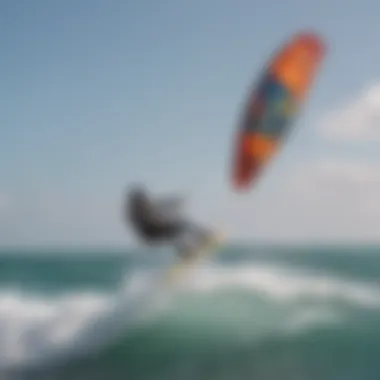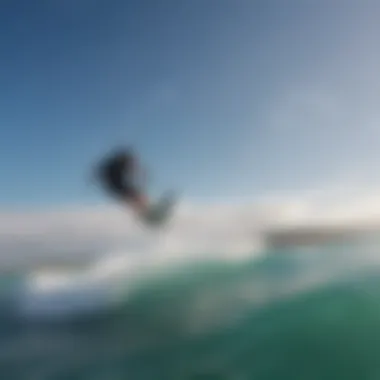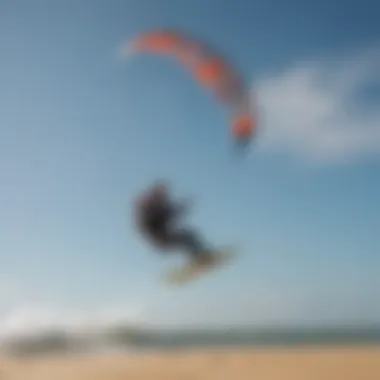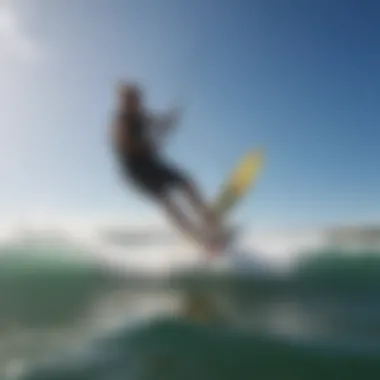Exploring Track 9: The Ultimate Kitesurfing Guide


Intro
Kitesurfing encompasses a exhilarating combination of thrills from the wind and the waves. Central to this activity is understanding "Track 9", a thematic concept that serves as a foundation for mastering the art of kitesurfing. This guide isn't merely about the rudiments but delves into all encompassing insights for enthusiasts of varying skill levels. By exploring key equipment, locations, techniques, and safety protocols, the article aims to elevate the understanding of what it means to ride the winds. Whether you are beginning your journey or honing your advanced skills, the knowledge gathered here seeks to enhance your experience on the water.
Equipment Reviews
Kites
When looking for kites, understanding the various models available plays a vital role. There is a variety of kite shapes such as C-kites, Delta kites, and Bow kites. Each shape serves distinct purposes.
- C-kites offer great power and control, suitable for advanced riders who want to perform tricks.
- Delta kites are more forgiving, making them ideal for beginners as they handle gusty winds well.
- Bow kites typically provide a larger wind range, allowing flexibility when conditions change.
Further, the sizes of the kites matter. Smaller kites are more maneuverable but less powerful, whereas larger kites require more wind and can quickly become too forceful for novices. Brands like Cabrinha, F-One, and Duotone, offer commendable options, each with specific features that enhance performance.
Boards
Next, kiteboarding boards come in two significant types: twintips and directional boards. Twintips are versatile, allowing riders to go in both directions. Their symmetrical design permits fluid movement on the water, catering to a range of riding styles.
On the other hand, directional boards have a defined nose and tail and are favored for wave riding. Their various constructions determine weight and responsiveness, making it necessary for riders to assess during their selection. Notable manufacturers include Naish and Slingshot, providing boards crafted for various experiences and skill levels.
Accessories
Accessories cannot be neglected when gaining proficiency in kitesurfing. Critical items include harnesses, safety lines, pumps, and safety gear. Each accessory holds significance, ensuring both comfort and safety.
- Harnesses secure the kite to the body, so choosing a comfortable design enhances pleasure.
- Lines must be durable and should ensure an optimal kite response.
For best results, it is necessary to invest in high-quality accessories to create a seamless experience while kitesurfing. Regular assessments of the gear enhance its lifespan and guarantee safer rides.
"The right equipment can define your kitesurfing experience, leading to greater exploration and enthusiasm on the water."
Travel Destinations
Popular Spots
Kitesurfing's geographical diversity opens the door to many unique locations around the world. Frequently recognized areas like Tarifa in Spain, Cabarete in the Dominican Republic, and the Canary Islands provide excellent kitesurfing conditions.
Noise and excitement surround Tarifa, averaging consistent winds nearly whole year, attracting many riders. Meanwhile, Cabarete's ideal climate and local amenities make it a popular destination.
Off the Beaten Path
On the flip side, lesser-known hotspots such as Hainan Island in China or Cumbuco in Brazil might offer quantifiable benefits. Cumbuco brings rich local experiences as you combine kitesurfing with culture, making the session even more immersive. Having the knowledge from this guide, one can discover alternative spots which also bring endless excitement.
Techniques and Tutorials
Beginner Guides
Initiating the path into kitesurfing can begin with launching your kite and practicing balance on the board. Here are some steps to consider for seamless beginnings:
- Set your kite in the correct position.
- Develop the ability to ride and balance on the board.
- Gradually practice turning.
- Recognize how to land optimally.
These fundamentals are cornerstone concepts for building more complicated maneuvers later on.
Advanced Skills
Once you feel comfortable with basics, exploring advanced skills awaits. For techniques such as jumps or adding diversity to your ride, understanding your body's dynamics becomes necessary. Focused planning can pave the way for smoother, controlled experiences.
Safety Guidelines
Weather Conditions
Grasping weather patterns enhances not only skill but also survival strategies. Understanding wind strengths, and understanding the calming trickle of night winds or the ferocity during storms is vital. Regular assessment also prepares the rider to adapt wisely.


Emergency Protocols
Planning for emergencies prepares you for unforeseen circumstances. Knowing rescue techniques enables quick responses when mishaps occur. It doesn’t guarantee that they will NOT happen, but preparedness is critical.
Equipment Maintenance
Ongoing checks of drag, stones, or damage are necessary routines to implement. Keeping gear well-maintained maintains efficiency and keeps safety integral during kitesurfing contemporary practices.
Educating oneself about kitesurfing across all its aspects ensures higher enjoyment levels responsibly entertained. As this guide unfolds in richness, enthusiasts can truly celebrate every ride created beneath the sun and the challenging waves.
Prelude to Track
In kitesurfing, understanding the core elements that define a specific technique or area of expertise is crucial for both safety and performance. The concept of 'Track 9' stands out as a significant component of kitesurfing practice, offering riders unique ways to engage with the conditions on the water. This section serves as an entry point to grasp not just the terminology but the implications and skills associated with Track 9.
Defining Track in Kitesurfing
Track 9 refers to the specific trajectory and behavior of the kite relative to the rider and water conditions. This includes not only the angle and movement of the kite but also how it interacts with the board and water surface. Proper knowledge of Track 9 enables riders to optimize their control and leverage wind force effectively.
For instance, understanding the stakes of positioning the kite at various angles can directly affect speed, directional stability, and ultimately, the fun of kitesurfing. Competent manipulation of Track 9 can enhance performance, making turns smoother and jumps higher.
Historical Context
The evolution of kitesurfing has seen Track 9 emerge from diverse cultural influences on the water sports scene. Initially rooted in early windsurfing models, kitesurfing gained momentum in the late 20th century through creative experimentation. As enthusiasts began to dissect techniques more critically, subsequent generations built on the legacy of flyers like before them.
Tracks, including Track 9, began to be defined as the sport grew more mainstream, heavily influenced by advancements in kite technology and understanding of hydrodynamics. Concepts were codified within the community facilitating a structured approach to learning kitesurfing maneuvers, thus in turn enhancing safety and skills development.
In summary, Track 9 reflects both an individual rider's proficiency and the socio-technical journey of kitesurfing culture. Gaining insights into what defines Track 9 is imperative for understanding both the mechanics of the sport and its historical considerations.
Understanding the Mechanics of Track
Understanding the mechanics of Track 9 is fundamental to achieving success in kitesurfing. This section delves into the interaction between wind and water, as well as the dynamics of the kite. A grasp of these concepts not only enhances a kitesurfer's skills but also elevates their safety and enjoyment.
The Role of Wind and Water Interaction
Wind is the primary force behind kitesurfing. Its direction and intensity greatly impact the experience of boarders on the water.
- Wind Patterns: Understanding local wind patterns helps riders select the right times for a session. Wind can be classified into onshore, offshore, and cross-shore. Each type provides different challenges and advantages.
- Water Conditions: The sea surface also matters. Choppy water can make for an unstable ride, while flat water allows for smoother moves and higher speeds.
- Lift Creation: Wind interacts with the kite's surface to create lift. This lift determines how high the kite can fly and the consequent maneuverability a rider has.
Paying heed to both wind and water decreases risks of injury and increases overall comfort. Whether you’re practicing jumps or maintaining stability, understanding these dynamics is vital.
Kite Dynamics Explained
Kite dynamics cover the forces at play during kite flying. Knowing these allows riders to refine their techniques.
- Angle of Attack: This refers to the angle between the body of the kite and the wind. A correct angle maximizes lift but requires finesse. Too steep may stall a kite; too shallow leads to low lift.
- Control Systems: Riders utilize control lines to steer and perform tricks. The way tension is managed within those lines also greatly influences the kite's responsiveness.
- Weight Distribution: Proper stance and weight distribution on the board help manage the force of the kite. Shifting weight from back to front can enhance or reduce speed as needed.
\> Key functions of kite dynamics include influencing jumps, turns, and the overall ride experience.
Understanding kite dynamics enables riders to tap into better performance while reducing struggle against the inherent forces at play during kitesurfing. With a clear understanding, kitesurfers can maximize both efficiency and thrill.
Equipment Selection for Track
The right equipment is crucial in kitesurfing, especially when considering Track 9. Proper selection enhances performance and safety. As this sport evolves, so do the manufacturing technologies, creating a plethora of options for gear that caters to different skill sets. Choosing the appropriate kites and boards will significantly impact the kitesurfer's experience on the water.
Kite Types and Their Functions
Kites play a fundamental role in track performance. There are several varieties available, each designed for specific conditions and styles.
- C-Kites: Known for their solid performance in freestyle and tricks. They offer direct control and provide high lift.
- Delta Kites: These kites are versatile and easy to relaunch, making them ideal for all-around riding. They perform well in varying wind conditions.
- Bow Kites: Known for their wide wind range, these kites feature flatter profiles which offer more power and can be depowered easily.
- SLE Kites (Leading Edge Inflatable): Often seen in wave riding, these kites provide stability and have a quick response.
Choosing the right kite involves assessing factors like wind conditions, riding style, and the kitesurfer's skill level. Each kite type has its unique advantages, making compatibility with individual riding preferences crucial.


Board Specifications Suited for Track
Selecting the proper board is just as important as the kite. The board’s specs impact mobility and speed. Key requirements for a board suitable for Track 9 include:
- Length: Longer boards generally provide more stability than shorter ones. The typical length ranges between 130 cm and 160 cm, depending on weight and skill level.
- Width: A wider board means increased floatation, which is beneficial for lighter winds.
- Material: Most boards are made of fiberglass, carbon fiber, or wood (for beginner options). Type of material affects rigidity and weight.
- Rockers: A moderate rocker allows better performance for jumping, while a flat rocker provides speed in flat water environments.
The board’s design elements affect handling, especially on turns and stability during jumps. It's necessary to test different models before deciding.
Safety Gear Requirements
Safety is paramount in kitesurfing. As waves and winds can pose risks, proper gear reduces injury potential. Essential safety equipment includes:
- Impact Vest: This protects the body upon entrance to the water after jumps.
- Helmet: A strong yet lightweight helmet can save against head injuries, which is especially important in challenging waves.
- Harness: Opt for a comfortable and snug harness. Seat harnesses provide lower back support while waist harnesses allow freedom of movement.
- Safety Leash: An essential component, this system allows fast detachment from the kite. Tripped or involuntarily launches require immediate disconnecting to avoid accidents.
- Emergency flotation device: Some models can offer additional buoyancy if ocular capabilities fail due to fatigue.
By ensuring the right gear is in place, riders can focus on honing skills while navigating the waters. Safety risks significantly reduce when appropriate precautions are considered and implemented.
"Equipping thoroughly can lead to both leaning towards skill and understanding of the possibilities and risks imminent in kitesurfing."
In sum, careful selection of equipment is indispensable for a fulfilling experience on Track 9. What works for one kitesurfer may not work for another, yet sticking to safe practices guarantees that pursuits remain enjoyable and safe.
Techniques for Mastering Track
Mastering Track 9 requires refined techniques that enhance performance and safety. Each subheading below explores pivotal strategies essential for ensuring a competent and enjoyable kitesurfing experience. Gaining proficiency in launching, turning, and remaining stable can drastically improve your time on the water.
Launching and Landing Strategies
Launching and landing properly are crucial points in kitesurfing. A secure launch prepares the conditions for successful riding, while an efficient landing is just as meaningful. Here are points to consider:
- Choose the Right Spot: Look for areas free of obstacles like trees or buildings.
- Coordinated Teamwork: If you have a partner, communicate clearly to avoid any mishaps during the launch process.
- Check Wind Direction: Use a wind indicator to judge the wind flow accurately. Always launch into the wind.
- Body Positioning: Stand with your back towards the wind, holding the kite low. This helps give it clearance as you launch.
Following these steps establishes a strong foundation, ensuring kite control right from the start. Breakdown in these steps can lead to falls and frustration—both avoidable through practice and patience.
Turning and Carving Techniques
Turning and carving skills legitimize a kitesurfer's style. Proper execution not only elevates performance but enhandces the enjoyment of every session. Key elements include:
- Use Your Hips: Shift your body weight toward the direction you wish to turn.
- Lean into the Turn: Depending on your speed, add lean both from your upper body and legs to create momentum.
- Hand Adjustment: Adjusting the kite's position foiling helps tighten turns. Keep your kite low when starting the turn for carving.
Continuous practice with these techniques allows for more lifelong surfing skills, as you learn to balance speed and control.
Staying Stable on Track
Stability is vital when mastering Track 9. Losing balance can result in uncontrollable movements and potential danger. Consider this advice for better stability:
- Body Positioning: Stand with feet shoulder-width apart. This stance allows strong leverage against choppy water.
- Kite Control: Maintain an optimal height based on wind strength; a lower kite may feel safer but also requires caution in turns.
- Focus on Your Core: Engage your core muscles. A stable core aids balance and improves response time.
Notes for stability ultimately increase a rider's confidence, making the experience both safer and more enjoyable.
Remember, consistent practice and awareness are keys to improving one’s kitesurfing techniques. Fine-tuning skills requires respecting the natural elements and adaptability.
Safety Protocols for Track
Safety is a cornerstone of the kitesurfing experience, particularly when navigating Track 9. This section explicates the essential safety protocols that all practitioners should heed to enhance their well-being and that of others while enjoying this adrenaline-fueled activity. Such protocols are not only about averting issues but also about fostering a culture of mindfulness and responsibility within the kitesurfing community. This will contribute significantly to a more sustainable and enjoyable environment.
Understanding Local Conditions
Grasping local conditions is paramount for kitesurfers wishing to excel in Track 9. Variations in wind patterns, tidal changes, and geographical features can heavily influence the kitesurfing experience. Here are some vital considerations:
- Wind Strength: Understanding the local wind strength, which is typically measured in knots, helps guide kitesurfers in selecting the appropriate gear.
- Tide Levels: High and low tide significantly affect water depth and potential hazards underneath the water.
- Obstacles: Identifying rocks, reefs, and other disturbances along the kitesurfing track is crucial in preventing accidents. Pre-riding reconnaissance is highly advised.
Be attentive to weather updates that could impact conditions suddenly. A reliable local wind forecast can transform an average session into an extraordinary one. Gather knowledge from local riders, and understand their experiences to supply yourself with a robust foundation of insight.


Environmental Considerations
Understanding the environmental considerations surrounding kitesurfing is increasingly critical. As the sport burgeons in popularity, enthusiasts must recognize their responsibility towards natural ecosystems. The environment’s condition heavily influences kitesurfing practices. A careful approach not only preserves recreational spaces but also contributes to maintaining biodiversity.
Impact of Kitesurfing on Eco-systems
Kitesurfing does interact with various natural environments. Water bodies can be affected by human activities that disturb marine habitats. Corals and shallow reefs, for example, are sensitive to turbulence caused by boards stirring up sediment. Additionally, local wildlife, such as birds and fish, can respond adversely if disturbed by kiters traversing too close to nesting grounds or crucial breeding areas. Keeping clear of such spaces protects these species and lessens the environmental footprint of the sport.
- Turbulence from boards can negatively impact the seabed.
- Noise disruption from kites can affect local fauna.
- Pollution from litter or careless disposal of equipment.
It is essential to engage with local environmental studies, if available, to better understand the specific impacts of kitesurfing in particular locations.
Key Point: Knowledge of the local ecosystem helps kitesurfers preserve the environments they enjoy, ensuring sustainability.
Sustainable Practices in Kitesurfing
Sustainability in kitesurfing revolves around adopting practices that mitigate damage to ecosystems. Minimizing gear waste is an important consideration. Enthusiasts should consider using gear from manufacturers committed to responsible practices.
- Choose eco-friendly equipment, such as organic solar sails or biodegradable components.
- Engage in cleanup events at popular kitesurfing spots.
- Promote education regarding environmental considerations within the kitesurfing community.
Moreover, learning to adapt to local weather patterns plays a key role in eco-conscious kitesurfing. Understanding wind and tidal currents can often lead to safer and less invasive maneuvers during sessions.
Ultimately, fostering an environment-first mindset not only enhances the sport but safeguards it for future practitioners. Kitesurfing benefits greatly from respecting ecosystems and taking thoughtful, sustainable steps. This, in turn, can create a lasting culture of environmental stewardship within the sport.
Community and Culture Surrounding Track
Kitesurfing is not just about the thrill of riding the waves or harnessing the wind; it also deeply involves the community and culture that envelop Track 9. Understanding this aspect enhances one's experience, fostering connections that enrich not only skills but also the overall enjoyment of the sport.
Events and Competitions
Events and competitions play a vital role in cultivating a vibrant culture around Track 9. These gatherings provide platforms for kitesurfers of all levels to showcase their prowess. They also create a sense of camaraderie, uniting participants and spectators alike. Major kitesurfing competitions include the Kitesurf World Cup and the Red Bull King of the Air, drawing attention from enthusiasts worldwide.
These events are not only about winning; they also emphasize learning opportunities. Participants can observe advanced techniques and gain inspiration from seasoned riders. Those who do not compete may consider volunteering or assisting with organization tasks, which also fosters community spirit. Such activities encourage interaction among kitesurfers who share a passion for the sport.
Another notable benefit the events create is exposure to new products and innovations. Equipment brands take part in these gatherings, showcasing the latest kite designs, boards, and accessories. Costumers can connect with product experts and find tailored gear suited for Track 9, helping them to optimize their riding experience.
Networking within the Kitesurfing Community
Networking is crucial in the kitesurfing community surrounding Track 9. Engaging with fellow riders helps share knowledge and discover resources that enhance one's skillset. Different methods exist to make these connections. Local kitesurfing clubs often host meetups where enthusiasts discuss tips, gear, and local conditions that influence Track 9 experiences.
Social media platforms and forums such as Reddit and Facebook have become platforms for further engagement. Riders commonly form groups to share their progress, arrange group outings, and exchange tips based on personal experiences. Such connections create a supportive environment for both novices and seasoned kitesurfers.
In summary, understanding the community and culture surrounding Track 9 can significantly influence the kitesurfing experience. Emphasizing a mix of events, competitions, and effective networking encourages mutual growth. The collective inspiration and knowledge sharing that this culture fosters create a more enriching journey for every kitesurfer while deepening their engagement with the sport.
Future of Track in Kitesurfing
The future of Track 9 in kitesurfing is critical for participants of this sport. Knowing what to expect in coming years can enhance preparation and comfort while riding. New advancements increase performance and ensure the sustainability of environments favored by kitesurfers. Monitoring critical components, such as technology development and emerging trends, also informs behavior that encourages safer and more responsible practices. As riders advance in their skill levels, flexibility will be necessary to adapt to developments in this ever-evolving discipline.
Technological Innovations
Technological innovation leads the charge toward the enhancement of kitesurfing experiences. One significant advancement includes aerodynamically optimized kites designed to maximize lift and improve control in varying conditions. Lightweight materials are being used in kite construction, allowing for better maneuverability and responsiveness. This can positively influence performance, especially in areas like Track 9.
Another important innovation is in board design. Modern boards are often built with advanced composites that improve durability and performance characteristics. Innovations such as adjustable foot straps allow riders greater customizability for increased safety and control.
Smart technologies are making their way into the kitesurfing realm as well. For instance, GPS integrated systems on kitesurf boards help track jumps, speed and distance. This data provides users insights into performance, allowing for refinement and goal-setting.
The application of technology not only boosts performance but also enables the sport to attract new enthusiasts through alternative, exciting experiences.
Predicted Trends in Kitesurfing
Several trends are on the horizon that may affect the future landscape of Track 9 experiences. A return to the natural world is significant among them. There is a growing interest in eco-conscious equipment and opportunities for responsibly conducted practices among athletes. Expect to see more biodegradable materials in kite construction and gear usage emphasizing sustainability for the well-being of marine ecosystems.
Moreover, the introduction of more accessible materials decreases the entry barriers for beginners. This potential growth of a diverse fitness community surrounds safer riding practices and inclusivity.
Also, technological prowess combined with the rise in experienced riders is likely to inspire new tricks and performance-driven methods. These developments could set a competitive environment that aligns with events and competitions.
Both natural and industrial evolutions shape what will come. As kitesurfing continues to grow as a popular sport, understanding these changes will encourage involvement and foster a thriving future. By staying informed, the kitesurfing community can assure sustainability and create new avenues for enhanced experiences on Track 9.







